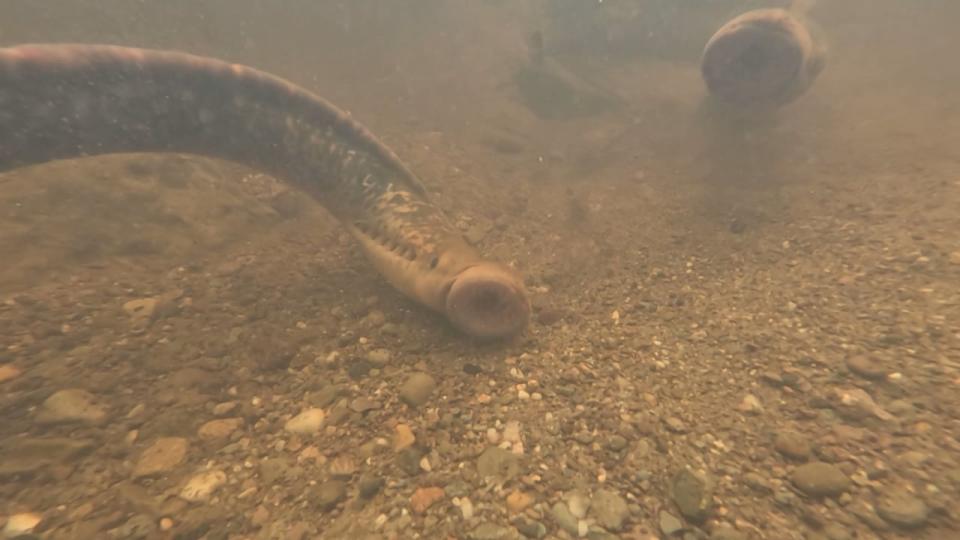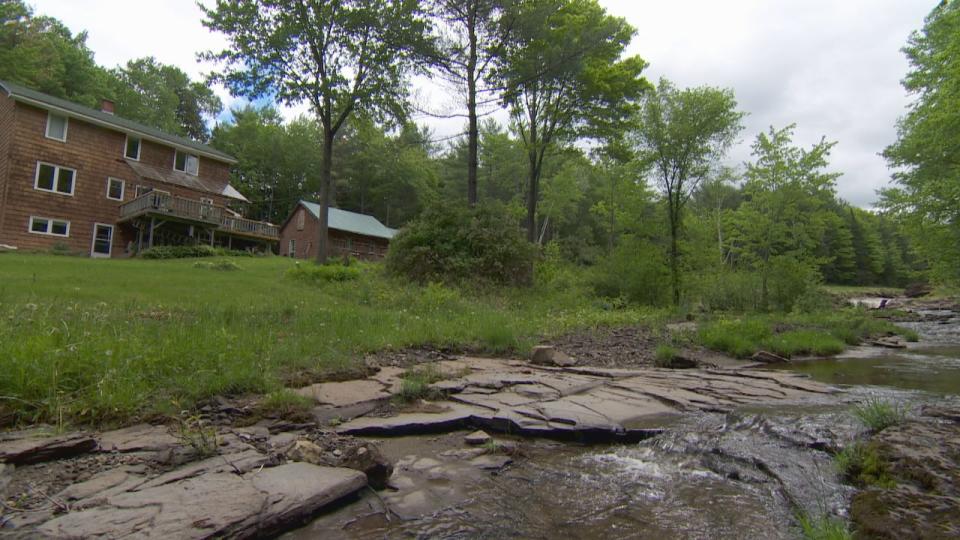Despite good intentions, Fredericton man says creek restoration 'a mess'

A much-touted waterway restoration project in Fredericton is facing erosion problems and its fish passage is not functional, says a resident who lives nearby.
"It's sad," said Tom Hickie, who lives on River Street in Marysville. "A lot of people were really good-intentioned.… They didn't want this to happen."
He said there was a lot of money spent and a lot of effort, "and there's a mess."
A dam behind Hickie's house, on Campbell Creek, was removed two-and-a-half years ago, with hopes of restoring the natural flow of the watercourse and to allow fish, including salmon and eels, to pass.
A waterfall and fishway were built just downstream from where the dam used to be.
Now, one of the banks just below the falls is bare, and the fishway is a bone-dry "jumble of rocks," Hickie said.

Tom Hickie says at first he was against removing the dam but was resigned to the fact that it had deteriorated beyond repair and had to go. Now, in spite of the current issues, he says he's generally happy to have a naturally flowing creek in his backyard. (Jennifer Sweet/CBC)
Pools in the creek have filled with sand. Scattered chunks of cement litter the bed.
Above the falls, large rocks that were placed to reinforce the banks have collapsed as dirt washed out from under them.
Pieces of cement, glass and metal protrude from the grassy banks and plastic tarps can be seen right next to the water, mixed in with the eroded soil.
The erosion problems started less than six months after the restoration project was completed, said Hickie, and with every rain storm the creek has grown wider.
WATCH | Creating a fish passage a good idea, except it didn't work, says Tom Hickie:
Last September, a very heavy rain event caused a major washout.
His opinion is that the restoration project was poorly planned.
"They didn't understand the hydrology in the brook … They didn't understand the geology of the rock," he said.

Hickie says a lot of cement has washed up in this area near his home. This photo shows a couple of big concrete boulders sitting in the creek. (Mike Heenan/CBC)
At the driest times of the year, the amount of water flowing through Campbell Creek is such that a pipe six inches in diameter would be big enough to carry it all, said Hickie. During the heaviest rain events, however, the flow would be more like 16 feet in diameter.
The creek bed is made of porous shale, which shatters and breaks off in freeze-thaw cycles.
Similar geology is visible on nearby rock faces along Route 8, he said.
"Underneath the rock it's like a chocolate chip cookie, and you can crumble it in your hand."
"It erodes underneath and then the rock top on top breaks off."

There's no water in what was supposed to be a fish passage, Hickie says. (Mike heenan/CBC)
Another part of the restoration project involved planting trees along the banks above the waterfall, which usually help to prevent erosion.
That didn't work out as planned either, said Hickie.
"Underneath that silt is nothing but sand. And when you have a dry summer, there's no water for the willows to grow.… I don't know how many hundreds were planted, but none of them came," he said.
Farther upstream, where the headpond used to be, tree trunks that have washed out are lying in the creek, said Hickie.
"I can't see why they didn't plant trees back there," he said.
"I'm sure eventually, the tons and tons of silt will all wash down into the Nashwaak."

Lamprey eels in below the falls where Hickie says there used to be a pool five feet deep. Sea lamprey spawn in freshwater streams. (Mike Heenan/CBC)
Hickie said he alerted the Nashwaak Watershed Association and the city to the issue last fall, and this spring he called the federal fisheries department, which is responsible for protecting aquatic ecosystems from negative impacts.
Last week city workers were there checking things out, he said.
A city spokesperson said no one was available for an interview about this, but sent an emailed statement.
It didn't acknowledge any issues with the former dam site or discuss any repair plans, but reiterated that the removal of the dam was deemed critical for ecosystem health and climate change resilience.

Another area of the creek where chunks of concrete have accumulated. (Mike Heenan/CBC)
It noted other partners backed the project, including Indigenous and conservation groups.
"Moving forward these partners will continue to monitor Campbell Creek as it stabilizes," said the email from Shasta Stairs.
Allyson Huestis of the Nashwaak Watershed Association said the site would indeed be remediated, but she doesn't know if her group will be directly involved, as they are mainly volunteers who do things like tree planting.
Huestis acknowledged that the main area of concern is the left bank below the falls.
The shale rock in the area came as a surprise, she said.
"You don't expect anything to be under bedrock."

Hickie would like the erosion addressed and the cement and other debris in the creek and near his house cleaned up. (Mike Heenan/CBC)
Hickie says he mentioned his observations and concerns about erosion while the project was under way, but was dismissed.
He'd previously been a vocal opponent of removing the dam but says, in the end, he was resigned to the fact that it had deteriorated beyond repair and had to go.
In spite of the current issues, he says he's generally happy to have a naturally flowing creek in his backyard.
"There's a waterfall. How can I complain?" he said.
He would however like the erosion addressed and the cement and other debris in the stream and near his house cleaned up.
"It is still very beautiful and down the road, when things straighten out, it should be a good habitat for wildlife and fish — if they fix it."


